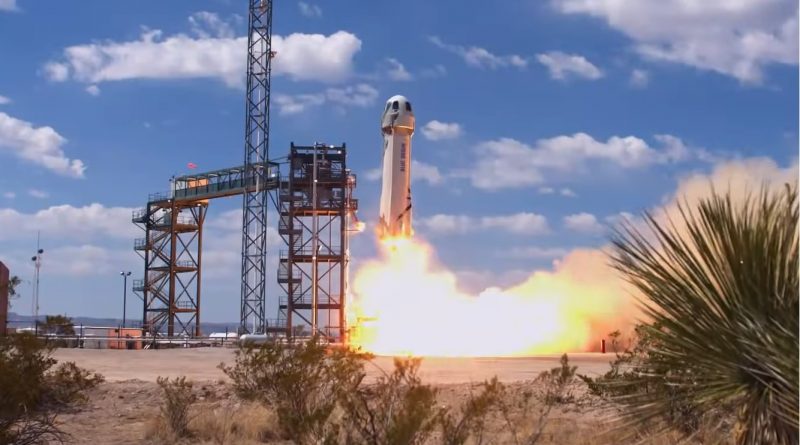Blue Origin’s New Shepard Reaches new Heights in latest Test Flight

Blue Origin returned to its West Texas testing grounds on Sunday for the eighth flight of its reusable New Shepard launch system – reaching new heights in a test designed to expand the vehicle’s operational envelope by sending it to a peak altitude of 107 Kilometers, a new record for New Shepard. Demonstrating that New Shepard can reliably lift its Crew Capsule above the Karman Line represents an important objective of the company’s drive toward beginning sub-orbital tourism flights as well as operational Zero-G science missions.
New Shepard fired up Hydrogen-fueled BE-3 engine at 17:06 UTC after the launch had to be pushed several times due to thunderstorms over Blue Origin’s test site and a series of minor technical hold-ups in the late stages of the countdown. Firing its single engine for two minutes and 23 seconds, New Shepard reached a peak speed of 984 meters per second and continued upwards for another minute and 40 seconds before falling back to Earth.
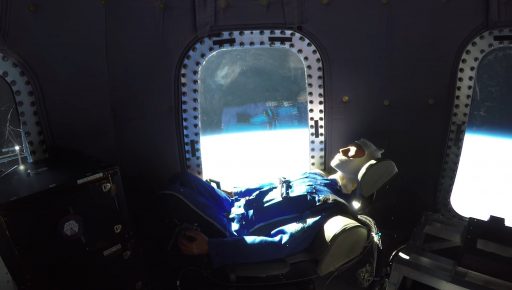
The previously-flown propulsion module deployed wedge fins and drag brakes as it fell back toward Earth and re-started its main engine just one Kilometer above ground level to come to a gentle touchdown on its deployable landing legs seven and a half minutes after taking off. For the crew capsule, the flight lasted ten minutes and 19 seconds – touching down under its three blue-and-orange parachutes and soft landing engines that slowed it to a landing speed of under four Kilometers per hour.
Sunday’s flight marked the second for this particular set of hardware, following up on the successful December 2017 mission that debuted “Crew Capsule 2.0” featuring large panoramic windows that are among Blue Origin’s prime selling points for tourist missions on New Shepard. Like for December’s mission, Sunday’s flight was host to “Mannequin Skywalker” – an instrumented test dummy to collect data on the environment human crew members would experience.
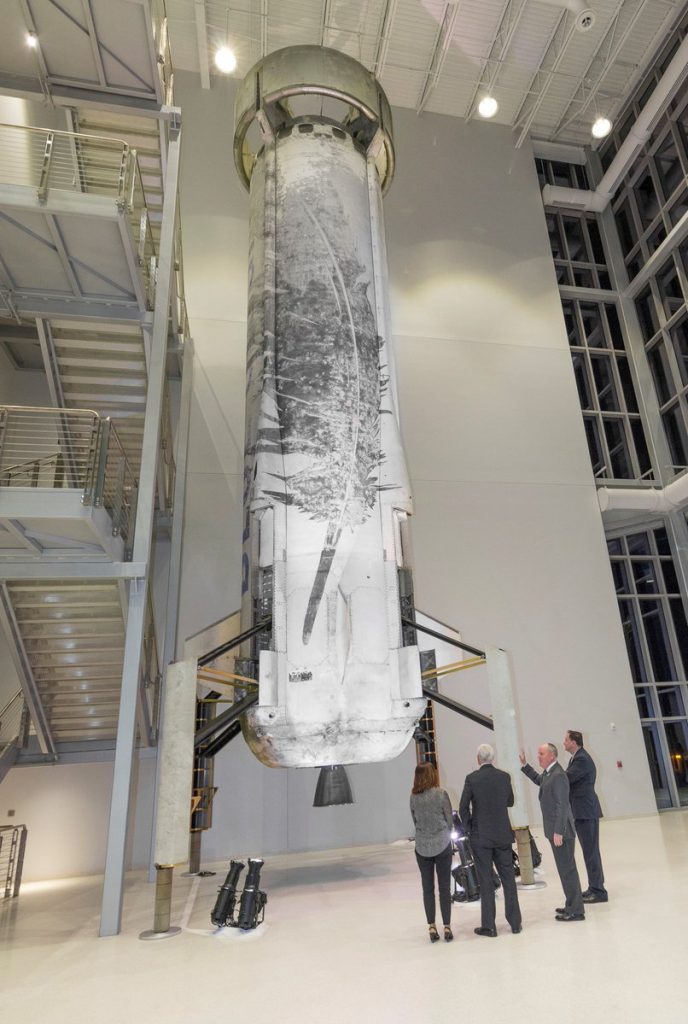
Overall, Sunday’s mission was the eighth in Blue Origin’s New Shepard flight test program that was off to a bumpy start in 2015 when the company lost their first Propulsion Module during its landing attempt. The second PM reached the launch pad in November of that year and was re-flown another four times over the course of 2016, testing out the regular flight regime, demonstrating a parachute-out capability on the Crew Capsule and culminating in a full-scale in-flight abort test in October 2016 that had the objective of verifying the Crew Capsule’s abort motor. This test was performed with the expectation of losing the Propulsion Module during the abort maneuver that had been timed for the most dynamic flight phase to create particularly challenging conditions.
However, New Shepard proved its strength and the Propulsion Module remained intact and successfully returned after supporting the in-flight abort, allowing it to head into graceful retirement. This retirement included a tour around the United States to various events before NS-2 was put on display at the company’s Space Coast factory where its much bigger brother, New Glenn, will be assembled.
New Shepard 1 and 2 provided Blue Origin with a number of important lessons regarding the operational aspects of their missions as well as the re-usability elements of the craft. Changes implemented over the course of the test program included improvements to the Reaction Control System algorithms used on the Crew Capsule and enhancements to the Propulsion Module landing sequence such as allowing the booster to land anywhere on its concrete landing pad as opposed to aiming for a perfect bullseye touchdown.
Over a year passed until New Shepard 3 was ready for launch – featuring improved thermal protection and provisions for more rapid servicing between flights, building on lessons learned from the first two Propulsion Modules.
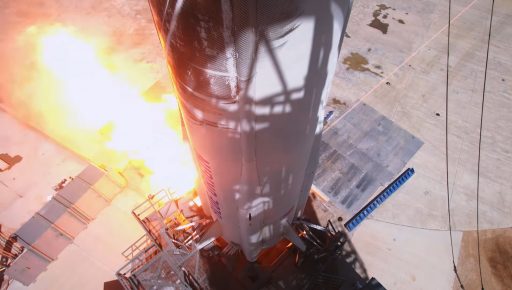
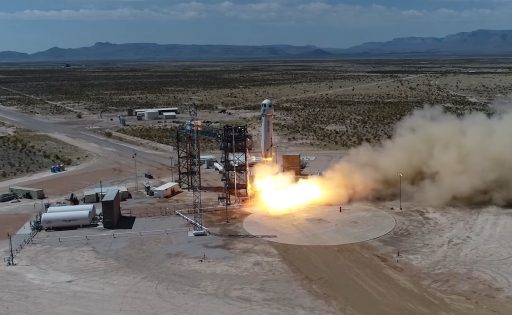
Starting with December’s mission, Blue Origin is operating New Shepard under a commercial launch license from the Federal Aviation Administration – upgrading from an experimental license granted on flight-by-flight basis during the initial test flights. While seeming like a mundane bureaucratic change, the commercial license enables Blue Origin to accept paying customers willing to place their research payloads on the New Shepard test flights.
Mission 8, as Sunday’s flight was called by Blue Origin, marked the second commercial Zero-G mission flown by New Shepard, carrying five utilization payloads from NASA’s Johnson Space Center, three German university payloads flown by the German Aerospace Center and a commercial tech demonstration payload flown by Solstar to test out a commercial in-space Wi-Fi System.
The NASA Suborbital Flight Experiment Monitor-2 is a sensor suite for the collection of various environment parameters inside the Crew Capsule (including carbon dioxide, pressure, acceleration and acoustics) to fully characterize the external factors experienced by payloads riding on New Shepard as part of future NASA Flight Opportunities Program missions. Additionally, the sensor suite validates a number of components that will fly on NASA’s Orion capsule.
The three DLR-sponsored payloads, named Daphnia, Equipage, and Euphorie were developed by the Universities of Bremen, Bayreuth, Magdeburg and Duisburg-Essen. Daphnia investigates the effects of microgravity on gene expression and the cytoskeleton of daphnia water fleas which are considered for future bioregenerative life support systems for long-duration space missions. The EQUIPAGE study looks at the motion of macroscopic rod shaped grains in microgravity conditions to validate predictive models for granular gases that can not be created in normal environments on Earth.
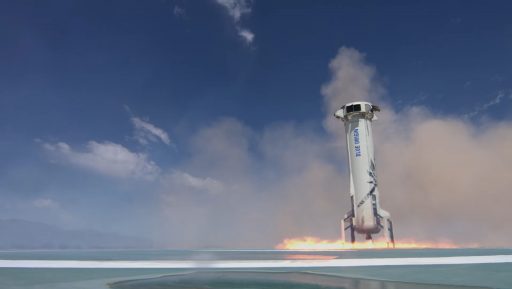
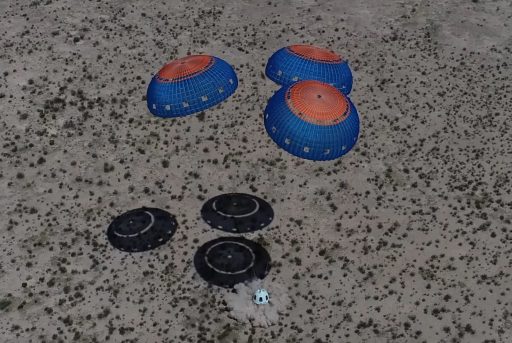
EUPHORIE investigates the process of photophoresis as a fundamental physics study. A laser is employed to heat solid particles suspended in a gas which will cause gas molecules on the heated side to warm up and induce the particle to accelerate toward the cooler side. Studying this process in microgravity will provide valuable insights into early solar system evolution and meteorite formation through stellar heating processes.
With the payloads packed into purpose-built Blue Origin Payload Lockers, New Shepard was wheeled to its launch pad at the former Corn Ranch site Sunday morning in preparation for an 8:30 a.m. local time launch window opening. However, thunderstorms caused the launch time to be pushed repeatedly and T-0 further slipped as a result of Blue Origin’s dynamic countdown which held several times with holds varying between a few seconds to several minutes to allow computers and/or controllers to deal with outstanding items.
Liftoff occurred at 17:06 UTC and New Shepard rose from its launch mount after its 50-metric ton force BE-3 engine was verified to be up and running. After a divert maneuver to clear the pad, New Shepard was headed straight up, burning its LOX/LH2 BE-3 engine until T+2 minutes and 23 seconds to accelerate the vehicle to a peak ascent speed of Mach 2.9.
NS-3 and the Crew Capsule 2.0 went on their separate ways half a minute later and continued coasting to an apogee altitude just under 107 Kilometers (351,000 feet) above ground level. On the way down, NS-3 reached a top speed of Mach 3.4 before deploying its forward wedge fins for stabilization and eight Drag Brakes to slow down for the landing burn. Re-starting the BE-3 engine just 1.1 Kilometers above the ground, the vehicle slowed down into a constant velocity descent of three meters per second for touchdown on four deployable landing legs.
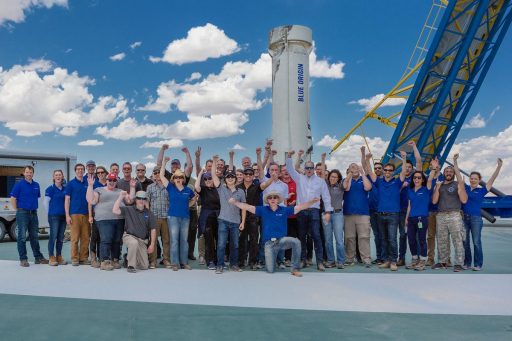
The crew capsule’s flight lasted ten minutes and 19 seconds, touching down under three blue-and-orange parachutes and with help of soft landing engines that slowed the vehicle to less than 0.5m/s for touchdown.
Blue Origin declared Sunday’s flight a full success, but – as is common for the company – did not elaborate what comes next for the New Shepard test program or when crewed test missions would begin.
In addition to tourist missions, New Shepard is envisioned to become a platform for science missions of all kinds, offering three minutes of very high-quality microgravity at an affordable cost for experiments that could not be realized on an orbital mission due to budgetary limitations. One selling point of New Shepard is its high launch pace, allowing for repetition of experiments under different conditions or with changed hardware not easily possible with an orbital mission.

